What Are Adhesions?
Table of Contents
Internal scar tissue, called adhesions, forms when the body heals from an accident, fall, surgery, infection, inflammation, trauma, radiation therapy, or endometriosis. Like scars that occur on the outside, adhesions are simply scars that form inside our bodies. Acting like powerful straight jackets, adhesions can squeeze nerves, organs, and joints – causing internal pain or dysfunction including female infertility and life-threatening bowel obstructions.
Clear Passage is a world leader with over two decades of experience breaking down scar tissue and adhesions non-surgically. Born from a female physical therapist’s need to relieve her own debilitating adhesion pain, our therapists have developed an effective method to decrease adhesive bonds – returning the body to an earlier state of pain-free mobility and function.
Unlike surgery, our treatment does not appear to create new adhesions. Complete the online Request Consultation form to receive a free phone consultation with an expert therapist to learn if our physio/physical therapy can help you.
Adhesions in the Body: Presentation by Larry Wurn (Video)
Larry Wurn, LMT, co-founder of Clear Passage, presents an overview of 30 years of studying and treating adhesions. With images compiled from a presentation at a conference of physicians, the video provides an in-depth overview of the biomechanics of adhesion formation and the ways in which manual physical therapy can be an effective treatment. We thank endogyn.com for some of the remarkable images of adhesions they provided for this educational video.
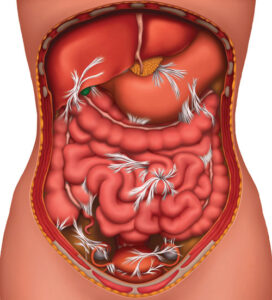
Adhesions form to help the body heal from surgery, infection or trauma. After healing, adhesions can create strong glue-like bonds that last a lifetime. Above is an image of abdominal adhesions.
Do I Have Adhesions?
Virtually everyone develops internal scar tissue, or adhesions, throughout life. Adhesions can form anywhere in the body as the first step in the healing process after an infection, inflammation, surgery, or trauma. (Liakakos et al., 2001) Our muscles, bones, nerves, blood vessels, and connective tissues are intimately involved structures within our body.
Most adhesions do not appear on diagnostic tests: x-rays, MRI, C-scans, or ultrasounds. The only way to definitively diagnose adhesions is by direct visualization during surgery. However, nearly all surgeries cause adhesions to form. Thus, the conservative approach requires us to examine a person’s history of healing events to determine whether adhesions are causing the pain or dysfunction
Symptoms of Adhesions
Like tiny but powerful straight jackets, adhesions can join structures from different bodily systems with strong glue-like bonds that can last a lifetime. As the body’s tissues heal and adhesions are formed, the tissues begin to shrink and pull, which results in restricted movement of the area. This ‘pull’ often creates mechanical irritation, generating more adhesion formation.
Adhesions may occur on the surface of our bodily structures or deep within them. Can adhesions cause pain? Yes, they can join any structure in the body to its neighbor or to distant structures, causing confusing symptoms of pain or dysfunction. For example, a fall on the hip or tailbone can cause adhesions to form as the body’s first healing response to that trauma. While a person may first feel the scar-tissue pain only at the hip or tailbone, adhesions can slowly spread to bind nearby organs such as the bowel, bladder, fallopian tubes, or ovaries.
Adhesions may be filmy or coarse, thick or thin. They may be small enough to join individual cells, deep within an organ. They can become large enough to attach structures from neck to waist, bending a person forward so s/he literally cannot stand erect.
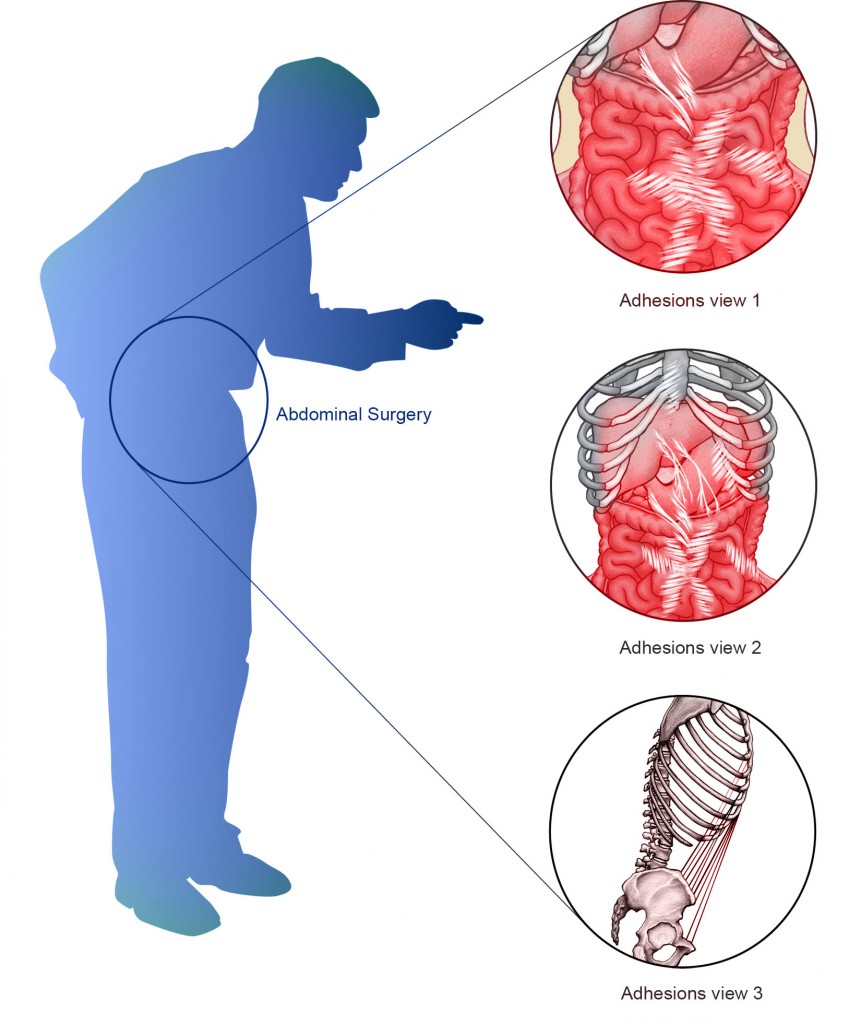
Abdominal adhesions can pull the body forward, making it difficult or impossible to stand straight.
What Causes Adhesions?
Surgery
Surgery is a primary cause of adhesions. An exhaustive study examining five decades of surgery showed that more than 90% of patients develop adhesions following open abdominal surgery and 55% to 100% of women develop adhesions after pelvic surgery. (Liakakos et al., 2001) In fact, surgery to remove adhesions has itself been implicated as a major cause of adhesion formation. Surgeries that may cause adhesions or scars to form in and around organs include:
- laparoscopy or laparotomy
- C-section or episiotomy
- appendectomy
- bowel obstruction repair
- complete or partial removal of organs
- back or hip surgery
- hysterectomy
- gastric bypass plastic surgery
- abortion
Many people experience pain, decreased function, or loss of range of motion after an injury, surgery, or infection. Like scars that form on the skin, adhesions are ’internal scars.’ They may become painful and inhibit proper function by adhering to tissues and organs that are designed to move freely. Mechanical problems can occur in the body as a result of adhesions that form when the body tries to compensate after the original injury, surgery, or infection. Learn more about our treatment for surgical adhesions.
Inflammation and Infection
Inflammation and infections are frequent causes of tissue damage and adhesions form as healing occurs. As the body starts the process of healing from inflammation, it can form blankets of collagenous crosslinks to contain the area that has become inflamed. After the inflammation ends, the blanket of adhesions remains in the area and may spread. Inflammatory and infectious processes that can cause adhesions include:
- SIBO
- colitis
- gastritis
- hepatitis
- diverticulitis
- appendicitis
- cholecystitis
- endometriosis
- gastroenteritis
- perforated ulcer
- cystitis or vaginitis
- pelvic inflammatory disease (PID)
- perforated diverticulum, small or large bowel
Accidents, Falls, Traumas
Adhesion-causing traumas include falls, accidents, and physical or sexual abuse. In addition, the trauma of radiation therapy can cause massive adhesion formation at or near the sites of cancer treatment. Inflammation following trauma or radiation therapy may cause adhesions to spread to neighboring organs, with symptoms sometimes appearing far from the site of the original trauma.
Adhesion-Related Disorders: Conditions Caused or Aggravated by Adhesions
Abdominal and Pelvic Adhesions
Adhesions that form in the abdomen can cause moderate to severe pain. Abdominal adhesions can cause ongoing digestive issues (e.g., bloating, diarrhea, constipation, painful bowel movements) as they squeeze the intestines or pull the tailbone forward. In severe cases, they can cause bowel obstructions, a life-threatening condition that slows or prevents food from passing through the digestive tract. In the case of SIBO (bacterial overgrowth), they can prevent treated bacteria from leaving the body, causing ongoing recurrences of the condition.
Patients with stomach or pelvic adhesions often report feeling as if parts of their body are bound in a straight jacket. In areas where they impose on pain-sensitive structures, they can cause constant or recurring pain. These adhesions can pull on structures distant from the original tissue trauma, causing distant dysfunction or referred pain in other areas of the body (e.g. up into the throat, down into the hip or leg.) Adhesions are typically the cause of the unexplained or complex patterns we see in many of our chronic pain patients.
Reproductive Tract and Uterine Adhesions
When adhesions occur around the uterus, ovaries, fallopian tubes, or the delicate fimbriae at the end of the fallopian tubes, pain or infertility may result. Adhesions can block fallopian tubes, cover ovaries, or cause inflammation on the walls of the uterus. Pelvic adhesions can decrease or totally stop reproductive function, even if they do not cause pain.
Adhesions are a major cause of female infertility as they form glue-like bonds within delicate reproductive structures.
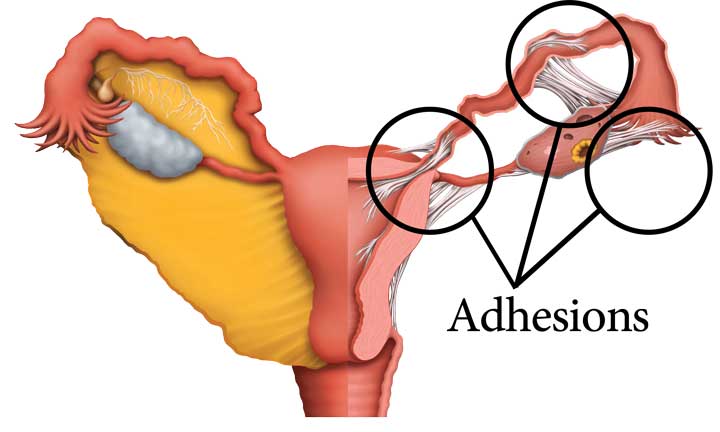
Tiny adhesions that form between muscle cells deep within the cervix may cause pain during sexual intercourse when the partner hits the cervix. Regardless of whether they cause pain, these adhesions can cause cervical stenosis (closing) or fibrosis (tightness), decreasing fertility and the ease of sperm transport into the uterus. The cervix is designed to be held in a midline position by four ligaments: to the pubic bones (in front), to the sacrum (in back), and to the pelvic walls (on each side). If any of these ligaments become adhered, the cervix is pulled by adhesions with each step a woman takes.
The vagina is a frequent site for adhesions that form after infection, endometriosis, or C-section. Treating this accessible area is generally very successful.
The constant pull of adhesions in the pelvis can cause inflammation in the uterus. The body’s response to inflammation is to send in adhesive crosslinks – tiny bonds that can form on the uterine wall or between the cells deep within the uterine walls. When this happens, uterine adhesions decrease the chance of egg implantation and pregnancy, thus increasing the chance of a miscarriage.
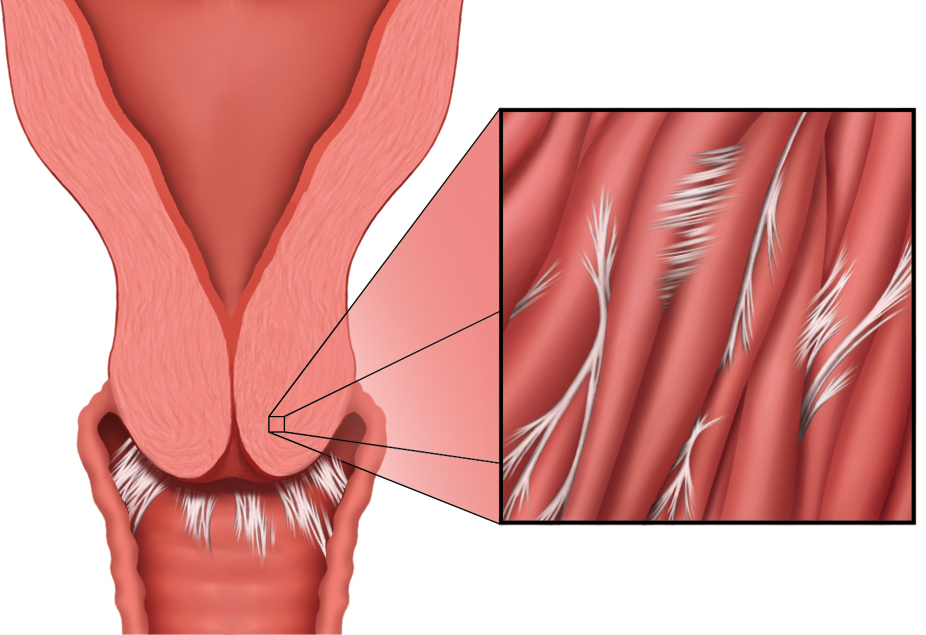
Above you can see another image of adhesions that have formed in a woman’s reproductive tract.
Adhesions in Joints
The joints of the human body require flexibility in order to function properly. When they have undergone an injury, or surgery – or been confined for a period of time, they can become adhered, restricting normal mobility. Our work is very effective at decreasing adhesions in stiff or immobile joints, usually returning them to the mobility they had before the adhesions formed. If you have these problems, please contact us for specific details related to your case.
Headaches
Adhesions at the base of the skull, in the neck or shoulders, or in tissues as remote as the tailbone can pull into the cranium with a force approaching 2,000 pounds per square inch. Frequently overlooked in the case of recurring headaches, these areas are often the key to unlocking and eliminating years of debilitating headache pain. Please contact us so we can discuss together whether this is likely the cause of your head pain.
How Does the Wurn Technique® Treat Adhesions?
We have helped many men, women and children overcome ongoing pain or dysfunction caused by scar tissue or adhesions. Our therapists use the Wurn Technique®, applying pressure and shearing to detach the crosslinks that adhesions are made of. Our primary therapy focus is treating adhesions affecting the soft tissues of the entire body:
We have helped many men, women and children overcome ongoing pain or dysfunction caused by scar tissue or adhesions. Our therapists use the Wurn Technique®, applying pressure and shearing to detach the crosslinks that adhesions are made of. Our primary therapy focus is treating adhesions affecting the soft tissues of the entire body:
- fascia, the connective tissue that supports and separates all of the body structures, and is the body’s main shock absorber
- muscles, which help us move
- organs, which help us function
- nerves, which alert us to problems, through pain
- ligaments, which connect bone to bone
- tendons, which connect muscles to bone
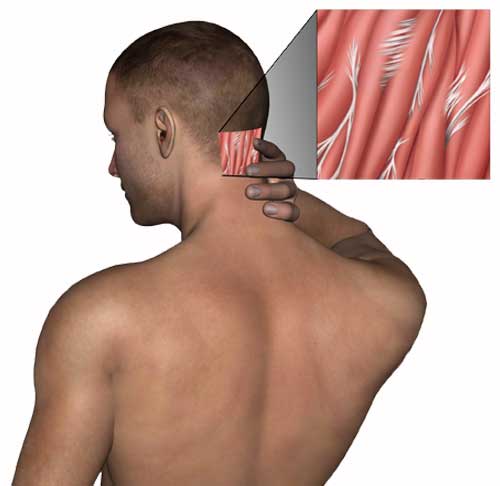
Freeing adhesions at the base of the skull is often the key to reversing years of debilitating headache pain.
Learn more about the Wurn Technique® and what to expect during treatment.
Other Treatments for Adhesions
Until recently, the only choice medical science offered to repair adhesive damage was a surgical procedure called lysis of adhesions. Whether performed by laparoscopy or open surgery, lysis involves cutting or burning the adhesions. While lysis of adhesions can be very effective, it has two major drawbacks:
- inadvertent enterotomy (IE): the damage caused by inadvertently cutting or burning nearby structures – something the surgeon cannot see until a patient is under anesthesia. A study from a surgical journal (Binenbaum & Goldfarb, 2006) suggests that the incidence of IE may be greater during laparoscopic surgery than during an open procedure due to the surgeon’s limited field of vision.
- despite the best skills of the finest surgeon, the body creates more adhesions to heal from the very surgery designed to remove them.
This second concern was highlighted in a large study of surgery patients. A 10-year study of nearly 30,000 patients published in Lancet noted that 35% of all open abdominal or pelvic surgery patients were readmitted to the hospital more than twice to treat post-surgical adhesions during the 10 years after their original surgery. Many follow-up surgeries (22%) occurred in the first year after surgery and “readmissions continued steadily throughout the 10-year period” of the study. (Ellis et al., 1999)
Like the patients in the study noted above, a number of our patients struggling with symptoms of adhesions have felt trapped in a cycle of surgery-adhesions-surgery – with no end in sight.
Related Content:
- Adhesions and Scar Tissue
- Abdominal / Pelvic Adhesions
- Fascia and Fascial Adhesions
- What You Need to Know About Pelvic Adhesions
- Do Abdominal Adhesions Show on an MRI Scan?
- Patient Story: No Longer Shackled by Adhesions
- 3 Ways Adhesions Cause Bowel Obstructions
- How to Prevent Surgery Adhesions
- Adhesions in the Body: Presentation by Larry Wurn (Video)
- Break the Adhesion-Surgery Cycle
- Lifesaving Therapy for Intestinal Obstructions Comes to St. Louis
- Pelvic Adhesions: What You May Not Know
- What Are Adhesions? (Infographic)
- Adhesions: What You Can’t See Can Hurt You
- How Can Therapy Help Adhesions
If you’d like a free consult, please take 20 minutes and fill out this form and we can determine if therapy would be a good fit for you.

















